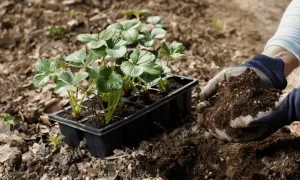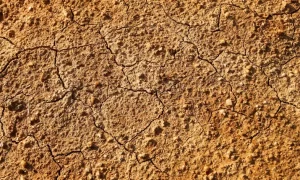Soil Types – Learn Which Ones Are Appropriate for Your Garden or Crop: In gardening and agriculture, it is essential to determine which soil types are present in the area of cultivation or are available. Because according to their physical and biochemical characteristics, certain fruits, vegetables, tubers, etc., can be harvested. Many will ask the simple question of how many types of soil there are or what type of soil is best for growing plants. But this is not as simple as it seems. Because the types vary according to the characteristic taken as a reference, soils can be classified according to their physical, chemical, and textural properties. But the best known is based on their structure, and we will explain it below.
Contents
- What Type of Soil is Best for Growing Plants? Existing types of soils
- Sandy soils
- What can be planted in Sandy Soils?
- Clay soils
- Loamy soils
- Limy soil
- Humic soils
- Saline soil
- Which plants can be grown in saline soils?
- Stony soils
- Peat soils
- Final Thoughts: What Type of Soil is Best for Growing Plants?
- What is the Best Soil type and why?
- What are the four types of Soil?
- How do I know my Soil type?
- Which is Black Soil?
What Type of Soil is Best for Growing Plants? Existing types of soils
Types of soil for gardening & agriculture are as follows with details:
Sandy soils
Sandy Soils is one of the main soils and stand out for having the largest particles compared to the other soils. This causes it to be rough and dry once it is touched. Since wide microscopic spaces space the particles. It also causes water to pass freely through the small channels between particles.
The sandy soil has excellent drainage. But, as far as nutrient storage is concerned, they are terrible. Therefore, they are not widely used in agriculture, except in some cases. There are plants with the right traits to take advantage of the minimum available nutrients and water, despite the drainage rate of sand.
Tips: Another characteristic of sandy soil is that it stores heat very well, absorbing it from its surroundings so that it can be warmer in early spring than any other soil.
What can be planted in Sandy Soils?
Plants that grow in sandy soil are carrots, potatoes, broccoli, eucalyptus, rosemary, lettuce, avocado, and palm trees.
Clay soils
Clay soil is composed of the finest possible particles, and although they are generally yellowish-reddish in color, there are different types of clays: illite, kaolinite, and montmorillonite.
Unlike sand, clay soil almost completely prevents water from seeping or draining, causing the cultivation area to become waterlogged. When it becomes wet, it acquires a sticky and plastic consistency and becomes significantly viscous, which hinders root ventilation, producing a favorable scenario for root rot.
Note: Despite its potential ability to rot roots, clay can contain many nutrients and organic matter, developing great fertility.
Loamy soils
Loamy soils are considered to be the best for plant growth. Loamy soils are mainly characterized by particles of intermediate size; between sand and clay. For this reason, they are softer than sand and have less plastic than clays. Consequently, they are soils that retain a portion of the water they receive and store an appreciable amount of nutrients.
The color that identifies silty soils is dark brown due to their peculiar composition of particles, similar to mud. They abound in river beds. And, they turn out to be very fertile, thanks to their humidity and nutrients; besides, they are effortless to cultivate compared to the other soils.
Characteristics
As one of the main soil types, we summarize below its most notable features:
- Tend to be stony.
- Acquire dark shades of brown.
- Drain water at a rate suitable for cultivation.
- The organic matter present in the silt decomposes rapidly.
Read more about How to measure soil moisture?
Some of the plants and trees that you can plant in loamy soils are the following: rice, lettuce, cabbage, artichokes, ash trees, oregano, oaks, and willows, among others.
Limy soil
Calcareous soil has a geochemical composition dominated by calcareous salts, such as calcium and magnesium carbonate, and may also contain traces of clays, quartz, and hematite. Its composition makes it a significantly dry and arid soil, being the most sterile of all soil types; the worst for agriculture. Its color is white due to the predominant presence of calcareous salts.
Note: Calcium carbonate is the leading cause of the sterility of limestone soil since it is a molecule that likes to react with water, drying the soil in the process and preventing the storage of nutrients.
Plants such as laurels and aromatic herbs can grow properly. However, plants such as fig, almond, pomegranate, and persimmon trees can grow under unfavorable conditions without support.
Humic soils
When you ask what type of soil is best for growing plants, Humic soil is another competitor.
Also called black earth, because of their striking dark color, these soils contain an abundant amount of decomposed organic matter, thanks to the millions of microorganisms that interact in their layers.
In addition, Humic soils retain enough water to create a humid environment conducive to cultivation. In these soils, it is normal to find abundant forms of life, especially annelids (worms), which excavate the soil by weaving a whole network of tunnels, increasing the ventilation of the roots. The quality indicator of humiferous soils is their dark color tone; the blacker the soil, the better. In agriculture, they are ideal soils for cultivation, and a wide variety of fruits and vegetables can be grown.
Saline soil
Like limestone soils, this soil has a high proportion of salts, a condition caused by the area they live in, which has a dry climate. Saline soil types are useless for agriculture, as they cause crops to grow little or not at all due to the concentration of soluble salts in the roots. This soil produces weak and fragile plants, with particular superficial white spots. Additionally, saline soils contain notable amounts of gypsum and reach a slightly alkaline pH; of less than 8.2. Also, these soils are known for their poor drainage capacity, making it impossible for salt to leach from the soil.
Which plants can be grown in saline soils?
Despite being hostile conditions for plant growth, some plants can withstand the adverse impact of saline soils. Among them, we can mention the following: acacia, maple, mulberry, common cypress, cedar, and carob.
Stony soils
As you can deduct from their name, these are soils composed of various stone formations. Stony soils are caused by splitting the earth’s surface, either natural or artificial. The geometric variety of the rocks in stony soils causes them to develop semi-impermeability, an unfavorable aspect for growing plants because they cannot retain water properly.
The plants that can survive in these soils, by natural merit, are xerophytes. However, with suitable measures, you can plant succulents, lavender, marigold, yarrow, and orchids, among others.
Recommendations: If you want to plant vegetables in stony soil types, you should combine them with fertile soil and fertilizers. If the soil has too many stones, we advise you to abort the mission since vegetables, and especially tubers can become deformed.
Peat soils
Finally, peat soils are remarkably suitable for agriculture because they can store large amounts of water and nutrients. Their characteristic color is dark brown and black, almost the same as black earth soils, but softer. Although peat soils can become saturated with water, their drainage can be improved with suitable measures. The dry months are when their water retention capacity is at its best, while in the winter months, they protect the roots thermally to maintain their warmth. These soils are acidic, with a pH ranging between 3.5 and 4.
In addition to cultivation, peat soils can be used to control the chemistry of other soils and the proliferation of pests. Thanks to its porosity and moisture, this soil is perfect for sowing seeds.
Read more about What do plants need to grow?
Final Thoughts: What Type of Soil is Best for Growing Plants?
We hope we have answered your question about what type of soil is best for growing plants. However, you should be aware that these eight soil varieties are not the only ones; there are other classifications. You have to find out which plant you want to grow and the best soil type for that plant. When you know these varieties of soils, it will be effortless for you to grow any plant.
Frequently Asked Questions
What is the Best Soil type and why?
Among the main soil types – Sand. Silt, and Clay, the best one regarding plants is Sandy Loam. It works even better when you compost the soil, especially for gardening. Learn more about Best Natural Fertilizer For Vegetable Garden.
What are the four types of Soil?
There are many different types of soil, but these four are the most known – Sand. Silt, Clay, and Loam.
How do I know my Soil type?
You can determine the soil type using three different techniques. They are – The ribbon test, squeeze test, and jar test.
Which is Black Soil?
Black soils are mineral soils that are rich in organic carbon. They have a black surface and are usually around 25 cm deep.




